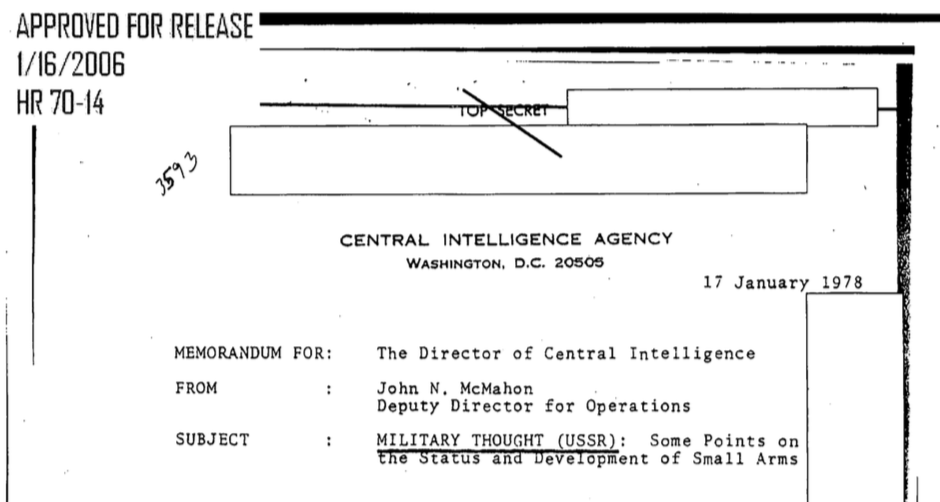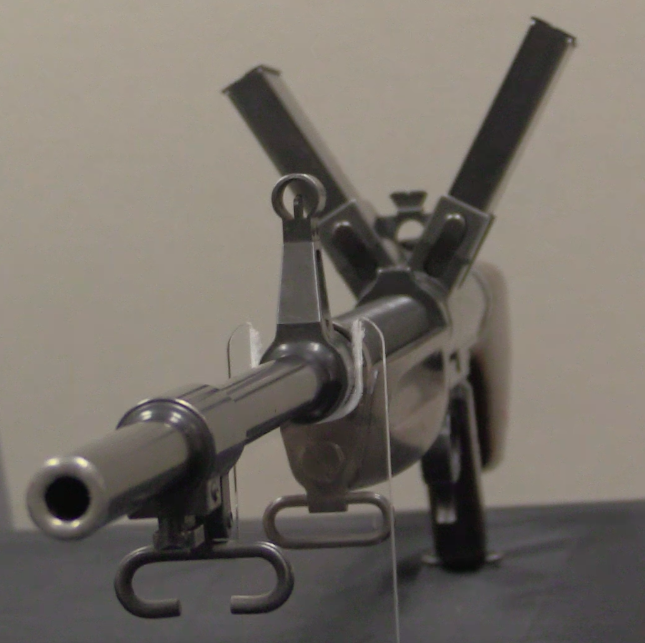In the previous video, we looked at the Winchester G30M rifle as it was submitted to Marine Corps trials in 1940. When the trial result came back with the G30M in last place, Winchester immediately assigned David Williams to work on adapting it to resolve the problems found in testing. What Williams did was to replace the tilting bolt with a virtual duplicate of the Garand’s two-lug rotating bolt. Williams also worked to reduce the weight of the gun, and was able to bring it down to a remarkable 7.5 pounds (3.4kg).
This prototype of the rifle (which Winchester optimistically designated the M2, implying that it would supercede the M1 Garand) was actually made largely from M1 Garand forgings, as Winchester was by this time build M1 rifles on contract. The receiver, bolt, and operating rod in this rifle was converted from Garand parts. Clearly it is not a finished product, and show many signs of being a shop prototype – but it was in this state when it was shown to ReneStudler of the Ordnance Department in early 1941. Studler was impressed by the design, but knew that it would not replace the M1 at that point. However, he urged Winchester to scale the gun down to the .30 Carbine cartridge (which Winchester had themselves developed) and submit it in the second round of the Light Rifle testing which was to happen soon.
Does a two-lug rotating bolt, short stroke gas tappet, and Garand-style operating rod sound like a familiar set of features? Well, there is good reason…
Winchester took Studler’s advice, and the scaled-down version was developed in just a few weeks and proved to be the best gun in the trials. It would be developed quickly into the M1 Carbine, and become the most-manufactured semiauto rifle of WWII. At that point Winchester would set aside the .30-06 side of this rifle design for a little while, as they had plenty of work now with M1 Garand and M1 Carbine production. But we will see the M2/G30M/G30 come back in new form in the next episode…




Nice looking rifle.
Very, very interesting. I had read much about the “light rifle” M1 carbine development, and yet watching this informative video was the first time I learned that Col. René Studler himself was the impetus for Winchester making the prototype it submitted for the second round of carbine trials.
I had surmised and speculated that the resemblance of the turning bolt of the Winchester carbine submission was liked by the committee since it resembled that of the M1 Garand self-loading rifle, but this confirms that, and adds the role of Col. Studler in noting Winchester’s accomplishment. “You [Winchester] won’t get a second look at the M2 since war is imminent, but make this up in .32 WCF/.30 carbine, and you might have a winner!” And indeed, winchester did.
This is incredibly interesting part of Winchester history; looks like Cody museum is turning into goldmine of learning.
So many radical alterations in time span of 10 years (taking to count first Ed B. rifle made in cooperation with this company – just amazing.
Btw, one thing which just takes me over is quality of woodwork, same on previous prototypes.
The gas system on this arm would not have been successful with the contemporary cal 30 ammo which was all corrosive primed. When the M1 Carbine was adopted with the Williams gas system the decision was made to produce all carbine ammo with non corrosive primers due to the difficulty of cleaning the gas system.
Good point. The only way this gas system would work with corrosive primers is if the cylinder, piston, and barrel were made of stainless steel.
It is a shame that Col. Studler didn’t suggest the 300 Savage round for the M2/M1 Carbine. Had he done so, we would have been the first Nation to have produced what is known today as the Assault Rifle. Instead, while the .30 carbine did all right, all we ended up with is a slightly overgrown submachinegun with about the same range and performance as the Ppsh-41.
One only has to look at Ruger’s version of the M1 carbine (Mini-14) in 7.62×39 to have an idea how well the more powerful 300 savage would have performed
I’ve never understood the process by which Col. Studler and other Ordnance officials, after arguing against the Army request for a light rifle design to replace the SMG, pistol, etc. in service, then settled on the warmed over .32 WCF cartridge–acknowledged as an accurate round, but also too underpowered for medium sized game–and set out the request for prototypes and entrants in trials based around that cartridge alone.
In a certain sense, the M1 carbine was an assault rifle ahead of its time, at least for U.S. service. And the U.S. Ordnance, having attacked the .45 acp M1911A1 under Studler’s tutelage to trumpet the Army’s carbine request, then turned around and denounced the carbine in Korea as inadequate and desired that the BAR, M1 rifle, M1 carbine, would all be replaced by the new-and-improved M1 rifle in the form of the M14! Only to then adopt SCHV 5.56mm AR/M16 not soon after… Having written off the British EM-2 7mm/.280 cartridge concept not too long before…! Onward through the fog.
PS: Had things gone the way of an obscure Soviet small arms technician trained by Fëdorov in the 1930s, the Soviets would have recognized the .25 Remington/6.5mm x 52mm with a 101-gr. bullet at 2350+fps. was the “ideal” infantry rifle cartridge!
Meanwhile, in the U.S. of A, the .276 Pedersen offered a 7x51mm cartridge with a 140gr. bullet going 2,400 fps., and a significantly lighter and handier rifle to shoot it out of… But “Caesar” Douglas MacArthur ruled since MGs used .30-06, and American ammunition lines produced .30 cal. cartridges, and war reserve stocks were all .30-06, and because ‘Merica! We’d have a .30-06 rifle thankyouverymuch…
Only to turn around ans sell about a quarter of that stock of ammunition to the UK for the Home Guard, and discover belatedly that the M1 Garand was “too much rifle” for service personnel, crews, drivers, officers, etc. of a highly mechanized army, for whom the M1 carbine was developed!
Depends on how you look at the dates. The M1 carbine predated the German “maschine carbine” project slightly, but the M1 had the select fire capability removed early and it was restored only in fall 1944 with the M2, about year after than the MP-43 had entered production in Germany. The semi-auto M1 was not an assault rifle and would not have been one even with a “true” intermediate cartridge. Full auto capability is an essential feature of an assault rifle (Something that modern press does not seem to know).